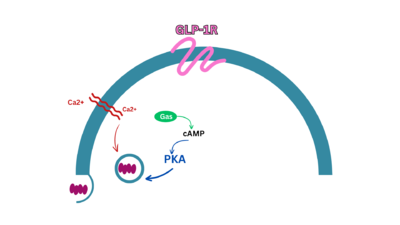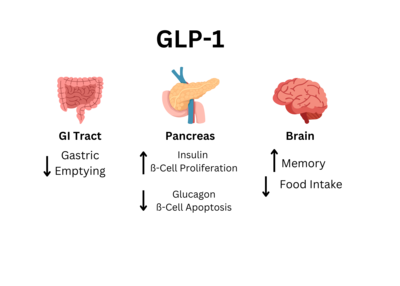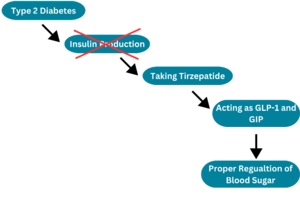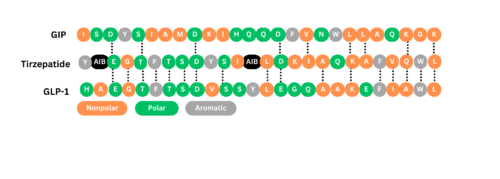User:Lily Lindemann/Sandbox1
From Proteopedia
< User:Lily Lindemann(Difference between revisions)
| (2 intermediate revisions not shown.) | |||
| Line 1: | Line 1: | ||
='''Glucagon-Like Peptide 1 Receptor (GLP1-R)'''= | ='''Glucagon-Like Peptide 1 Receptor (GLP1-R)'''= | ||
| - | <StructureSection load='6X18' size='500' side='right' caption='GLP bound to GLP-1R' scene='10/1038821/Receptor/1'> | + | <StructureSection load='6X18' size='500' side='right' caption='GLP bound to GLP-1R: The receptor is shown in pink, the ligand is in blue, the G-protein is in orange and the nanobody is in green. ' scene='10/1038821/Receptor/1'> |
[[Image:GLP11.png|400 px|right|thumb|Pathway of Insulin Secretion through GLP-1 Receptor]] | [[Image:GLP11.png|400 px|right|thumb|Pathway of Insulin Secretion through GLP-1 Receptor]] | ||
| Line 22: | Line 22: | ||
| - | Obesity is a disease caused by an accumulation of excess nutrients in the body, resulting in an increase of storage in the body. This disease can lead to the body having an insulin resistance. The insulin resistance can be caused by a large number of factors, from a persons genetics to their lifestyle choices. Once the body is unable to process insulin, the signal cascade is disrupted. The disruption can cause a person to develop Type II Diabetes. | + | Obesity is a disease caused by an accumulation of excess nutrients in the body, resulting in an increase of storage in the body.[https://obesitymedicine.org/blog/obesity-and-insulin-resistance/] This disease can lead to the body having an insulin resistance. The insulin resistance can be caused by a large number of factors, from a persons genetics to their lifestyle choices. Once the body is unable to process insulin, the signal cascade is disrupted. The disruption can cause a person to develop Type II Diabetes. |
| Line 30: | Line 30: | ||
=== Hormone Interactions === | === Hormone Interactions === | ||
| - | The <scene name='10/1038821/Hormone-receptor-intxn/1'>Hormone and Receptor Interactions</scene> start with the hormone docking in the N-terminus before moving the rest of the hormone into place. The ligand uses <scene name='10/1038821/Pi_stacking_hormone_receptor/ | + | The <scene name='10/1038821/Hormone-receptor-intxn/1'>Hormone and Receptor Interactions</scene> start with the hormone docking in the N-terminus before moving the rest of the hormone into place. The ligand uses <scene name='10/1038821/Pi_stacking_hormone_receptor/3'>pi stacking</scene> between two tryptophan residues to lock in the ligand at the C-terminus. There is also an hydrogen bond interaction between a glutamate and glutamine that keeps the ligand bound. |
=== Drug Interactions === | === Drug Interactions === | ||
The drug antagonist is shown in a mint color while the receptor is shown in pink. The interaction between Tirzepetide and the receptor are using | The drug antagonist is shown in a mint color while the receptor is shown in pink. The interaction between Tirzepetide and the receptor are using | ||
| - | <scene name='10/1038822/Trizep_receptor_trp/9'>pi stacking</scene> of the tryptophan residues. Which is a similar interaction as between the natural hormone and the receptor. The drug antagonist also uses <scene name='10/1038822/Trizep_receptor_interaction_2/ | + | <scene name='10/1038822/Trizep_receptor_trp/9'>pi stacking</scene> of the tryptophan residues. Which is a similar interaction as between the natural hormone and the receptor. The drug antagonist also uses <scene name='10/1038822/Trizep_receptor_interaction_2/13'>hydrogen bonding</scene> in the N terminus between a tyrosine and glutamate and also tyrosine and glutamine. |
== Relevance == | == Relevance == | ||
Current revision
Glucagon-Like Peptide 1 Receptor (GLP1-R)
| |||||||||||




